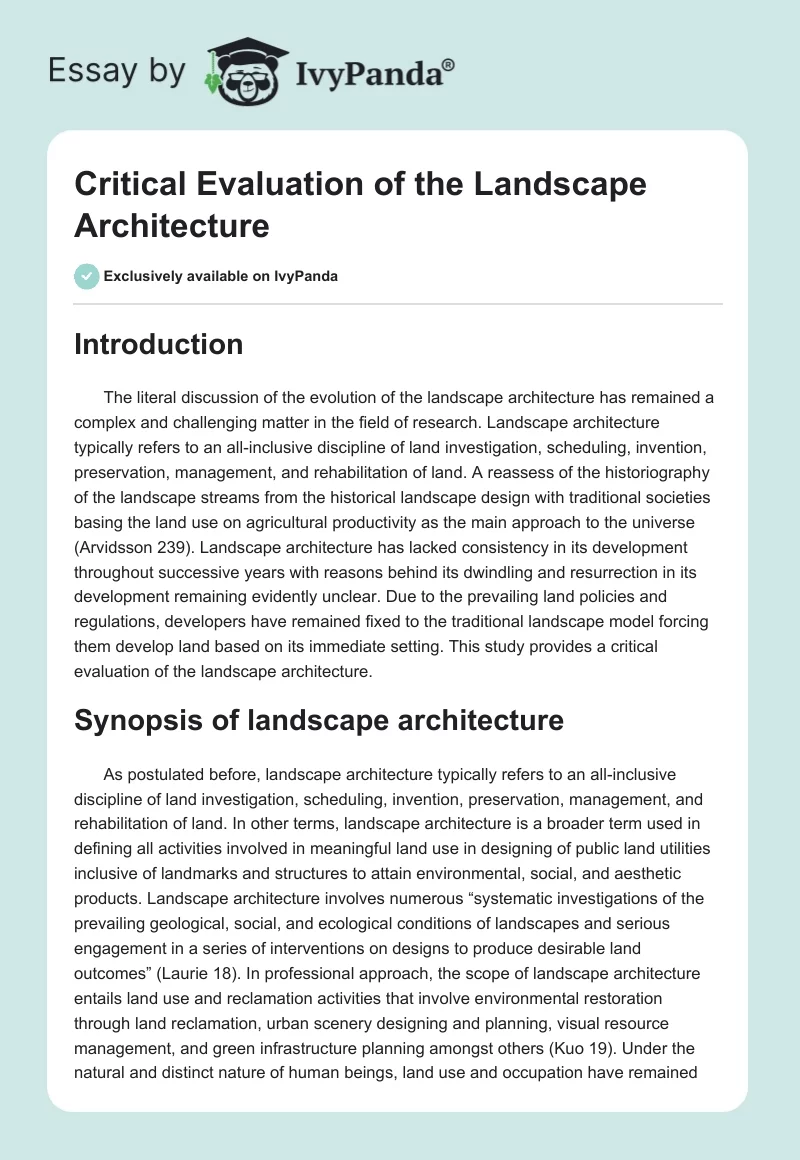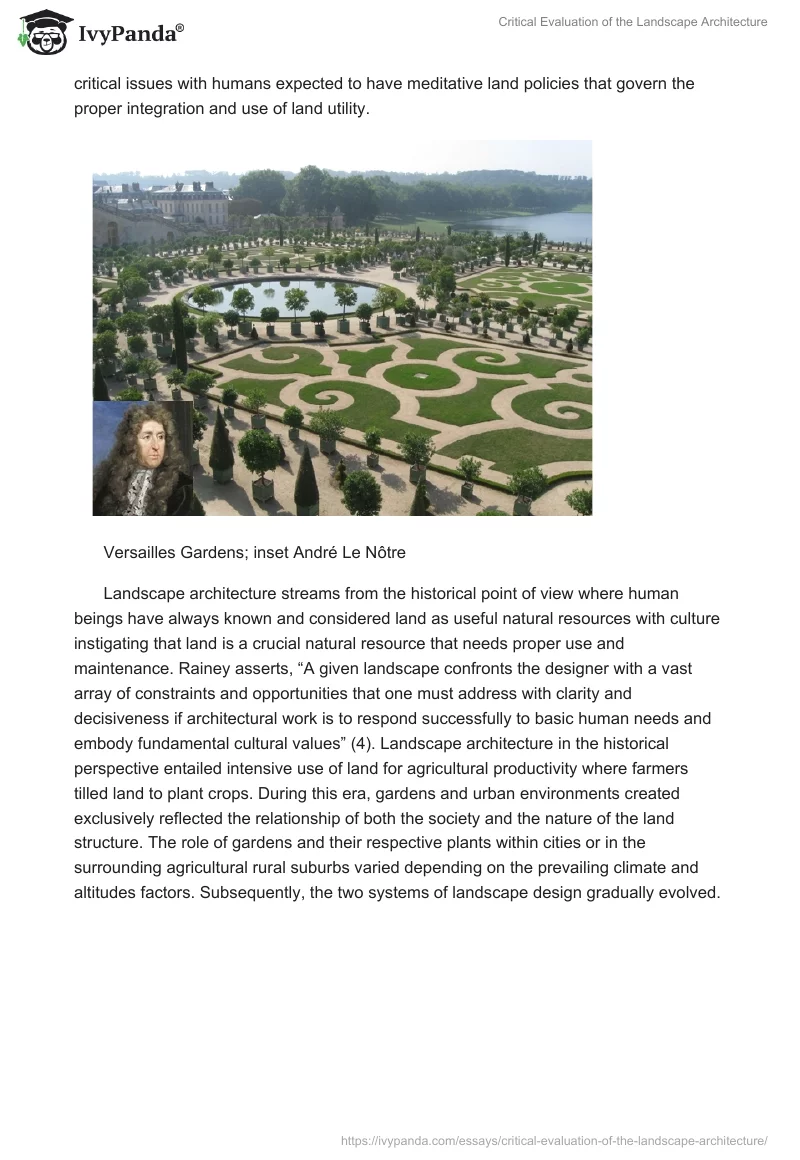Introduction
The literal discussion of the evolution of the landscape architecture has remained a complex and challenging matter in the field of research. Landscape architecture typically refers to an all-inclusive discipline of land investigation, scheduling, invention, preservation, management, and rehabilitation of land. A reassess of the historiography of the landscape streams from the historical landscape design with traditional societies basing the land use on agricultural productivity as the main approach to the universe (Arvidsson 239). Landscape architecture has lacked consistency in its development throughout successive years with reasons behind its dwindling and resurrection in its development remaining evidently unclear. Due to the prevailing land policies and regulations, developers have remained fixed to the traditional landscape model forcing them develop land based on its immediate setting. This study provides a critical evaluation of the landscape architecture.
Synopsis of landscape architecture
As postulated before, landscape architecture typically refers to an all-inclusive discipline of land investigation, scheduling, invention, preservation, management, and rehabilitation of land. In other terms, landscape architecture is a broader term used in defining all activities involved in meaningful land use in designing of public land utilities inclusive of landmarks and structures to attain environmental, social, and aesthetic products. Landscape architecture involves numerous “systematic investigations of the prevailing geological, social, and ecological conditions of landscapes and serious engagement in a series of interventions on designs to produce desirable land outcomes” (Laurie 18). In professional approach, the scope of landscape architecture entails land use and reclamation activities that involve environmental restoration through land reclamation, urban scenery designing and planning, visual resource management, and green infrastructure planning amongst others (Kuo 19). Under the natural and distinct nature of human beings, land use and occupation have remained critical issues with humans expected to have meditative land policies that govern the proper integration and use of land utility.

Landscape architecture streams from the historical point of view where human beings have always known and considered land as useful natural resources with culture instigating that land is a crucial natural resource that needs proper use and maintenance. Rainey asserts, “A given landscape confronts the designer with a vast array of constraints and opportunities that one must address with clarity and decisiveness if architectural work is to respond successfully to basic human needs and embody fundamental cultural values” (4). Landscape architecture in the historical perspective entailed intensive use of land for agricultural productivity where farmers tilled land to plant crops. During this era, gardens and urban environments created exclusively reflected the relationship of both the society and the nature of the land structure. The role of gardens and their respective plants within cities or in the surrounding agricultural rural suburbs varied depending on the prevailing climate and altitudes factors. Subsequently, the two systems of landscape design gradually evolved.
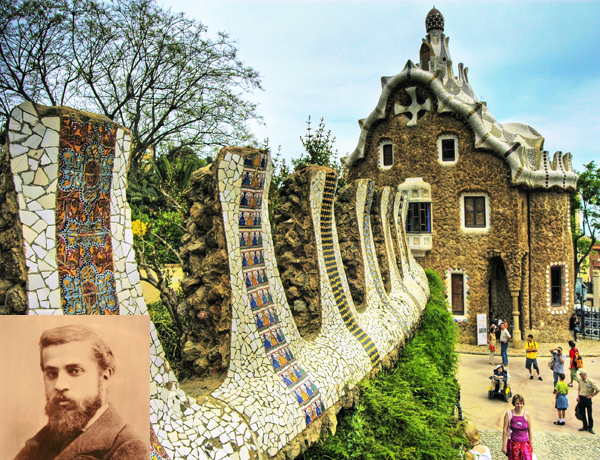
During this evolution period, the landscape design and architecture system changed from the traditional plant life and gardening system to more comprehensive and sophisticated designing based on geometry and nature. However, the practical meanings and the rationale of nature and geometry architectural design has consistently varied depending on place and time. Contrary to the past when ancestors considered land as holy, communally protected, and respected by the entire communities, land in the current era involves several corruptive tendencies with no sober approaches providing clear demarcations on proper land acquisition and its respective use. Rainey posits, “a typical strategy sets a building against a relatively swath of the natural environment” (4), thus breaching and undermining safety rules and policies governing the landscape architecture. Couple with intensive political power involving dictatorial commands and authorities, land has become the most socially and politically contested natural resource with aims of flaring personal wealth. Despite the fact that modern designers have incorporated better land designing systems, much remains anticipated.
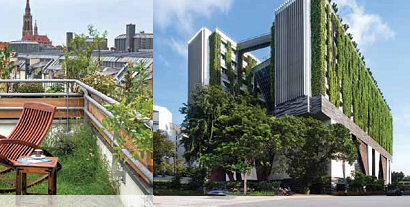
Resurgence of Land Architecture
The resurgence of land architecture may literally refer to the comeback or renaissance of the land planning profession after a moment of silence or doom. Several years back, the profession and activities of the landscape condensed. The modernized living of the nationalists across the globe, which immigration and other human aspects characterized it, has become the concrete reason behind the resurgence of landscape architecture in the last one decade. Historically, as stated by Courville and Patel, “A constant theme in conflicts over land is control, both of the land itself and of material resources and uses associated with it, such as water, wood, minerals, grazing and gathering” (3). However, the trend in this behavior has consistently revolutionized with the main controversy in the land aspect being property development. The postmodern social status across the world has gradually transformed with civilian opting to live the modern way and discern cultural living that sets landscape architecture to a more sophisticated form altogether.
Sprouting from its old agrarian age before the 1800 century when landscape architecture exclusively involved landscape gardening that included designing of gardens, manor houses, royal properties, and palaces to the most sophisticated designing inclusive of modern urban designing, the field remains overwhelming (Laurie 18). From the old schedule and the objectivity of the landscape architecture, more of royal building and emperor systems, the current world of landscape architectural designing has evolved to a more decent order guided by the objective of ensuring public safety, better health, and welfare as well as recognizing and protecting the land and its related resources. The landscape architectural profession has now positioned itself in a more manner appealing to the social welfare than to individuals. Currently, research has established that over 50 world states require landscape architects to carry out architectural duties and several countries have been eying for similar services. Coupled with stiffer legal frameworks guiding the use and reclamation of land, the modern landscape architecture is gradually gaining momentum.
For the last one decade or so, land architecture has consistently resurged with no clear directions towards correct path in landscape architecture. From the historical point of view, the survival of human being has predominantly depended on the availability of land and its comparative resources. As compared to the landscape architecture in the 1800 century, the last one decade has evolved from single empire, church, and royal property designing to more dynamic urban planning architecture that has consistently remained in great demand. However, the traditional landscape gardening has remained quite significant and designers have respected its pivotal role in the current world, since agriculture remains the livelihood of the great global populace. The modern landscape architecture has evolved with a combination of both modern city planning and rural planning being equally important, thus giving the profession a distinctive focus aimed at serving both needs. Streaming from 19th to 20th and 21st century, landscape architecture has nurtured designing disciplines that consistently shape the profession.

Reasons behind Resurgence of Land Architecture
The modern world and its unique development pace have always triggered immense changes in the social, political, and economical living of human beings across the world with natural behavioral traits remaining unexplainable beyond nature. Research has always cited immigration and migration human aspects as the forces behind the heaving radical socioeconomic change within the global development from the social, political, and even the economical angle. According to Courville and Patel, “early nineteenth-century land tenure reforms were often taken up, particularly in Latin America, by fledgling states as they struggled to break free from their colonial past” (5). As the immigration aspect intensified in the last one decade, governments have increasingly shifted their interest from the historical land tenure system to modern city planning architecture to accommodate the rising need for urban occupancies and populace. The trend in migration and immigration has remained the only challenge for governments across the world to control such human factors with the urge of shunning away from agrarian age increasing.
In the 19th century, the agrarian era received condemnations from the growing world with several individuals terming this era as a hindrance towards socio-economic development. Courville and Patel assert, “The agrarian question of the late nineteenth century pivoted on the role of the small-farm sector and the pace of capitalism’s movement into agricultural production” (5). Capitalism commenced and it was not in the agricultural realm, but manifested through the industrialization system. It has remained clear that many global changes became eminent in the late 19th century with diverse technology applications clearly proving imperative. Most importantly, the industrial revolution regime marked the aging out of the agrarian revolution. The modern city planning architectural system has always depended on the evolving world taking new approaches taking place across the globe (Aoki 36). The development of land from the agrarian regime has undergone global revolution from the nineteenth century into widespread professionalization of occupation across the globe. The trend in the industrialization has forced changes in modern architecture.
Perhaps the most intriguing issue in the current world that researchers cannot avoid mentioning in the recent researches is the issue of diversity in technology. The intensifying technological approach is gradually increasing the level of its dependence and increasing its effectiveness in carrying out both simple and complex human task. The digital and technological regime that has proven significant in the current era is contributing to both the prosperity and impasse of some issues across the globe with its diversification receiving a mixture of reaction from different quotas of the globe (Baird and Szczygiel 9). Serious investment in technology began in the nineteenth century as most facilities associated with this component penetrated from developed to developing nations. Architects are now improving the quality of urban land planning using technology with most structures invented posing threat to human life. Since the advent of technology in land planning building like skyscrapers have emerged as a form of global competition, the same technology continues to shape this profession.
Critical review in Resurgence of Land Architecture
The existence of world intense cultural and political dimensions with different perceptions across the globe has always proved as one of the greatly contested issues. Since the replacement of the agrarian revolution with the industrial revolution that meant to bring global changes from land utilization to land planning, debates have intensified with researcher aiming at finding possible conclusions on the current landscape architectural designing. Commonly described as the professional evolution of landscape architecture, the notions that land tenancy has changed from the agrarian use and traditional planning to modernized system of landscape architecture remain unappealing to most individuals. “Just as this notion was integral to the profession’s success in the nineteenth century, so too it proved critical to the profession in the last half of the twentieth century” (Baird and Szczygiel 11). There has been continual uneasiness about the existing professional definition, its interdisciplinary competition, and the public discernment. There has been debate over several modern architectural issues with research establishing them as the root cause.
The development of the landscape architecture from the landscape gardening to modernized urban planning architecture has never been appealing to all individuals across the world. The transition exhibited in the landscape architecture for the past one decade has remained a contentious issue in the context of landscaping approaches and the environmental concerns. The critical aspect of the landscape architecture arises in two most important edges where the concept of this profession remains a cause of disagreement. Rainey affirms that the “contrast juxtaposes architecture with the natural or cultural landscape, where at a typical strategy sets a building against a relatively untouched swath of the natural environment” (4). The greatest contradicting part in the widespread professionalization of architectural occupation has been the issue of proper land use involving the use land for human friendly practices (Knorr 17). It has been always a debated issue as the need for improving and protecting the environment across the world require more attention. Issues like human safety, health, and environmental protection are depreciating with the intensification of the modernized landscape planning.
Environmental issues in landscape architecture
Controversies in modernism of the landscape architecture began to lose the social edge in the 1940s. As postulated by Treib, the changes become more and more disillusioned with the merging changes in the landscape architecture as the regime marked the edge with the title “Modern Gardens for Modern Houses” (154). The main crucial aspect in the criticism involving modernized landscape architecture or the enhanced professionalism in the landscape architecture is the way modern architects are handling the issue of nature and the profession (Reed 200). The modern urban planning landscape architecture has revolved around the importance of making human comfort with competence among architects increasing, thus making the environment even more susceptible to harm. Architects are now interested in beauty concerning their physical structures with designing and planning ignoring environmental issues. Rainey postulates, “The building scale, profile, color, and materials act in concert to increase powerful counterpoint to its immediate setting” (4). Contrast employed by designers is eminent in those who understand nature as an important aspect of consideration in landscape architecture.
The cultural land and environment values are swaying away as the need to improve the technology in modern landscape architecture rises. Researchers have argued that designing a landscape must always acknowledge several biophysical forces that indeed an architect must remain informed in issues governing technical and design issues as well as cultural values. The modern housing design has ignored natural aspect of beauty despite the two factors largely depending on one another. Current architects have assumed the role of plants in enhancing beautiful sceneries with either few or even no trees, shrubs, and even flowers acknowledged in their planning. Treib postulates, “It is the quality of the second plateau that distinguishes landscape architecture from mere planting, it is only there, and new ideas are usually developed” (154).
Naturalistic and picturesque factor
The value for naturalistic factors in the context of growing modernized urban architecture is raising questions across the globe with the real meaning of architectural profession gradually diminishing. The traditional architect seems to be having a greater public appeal than the emerging modern landscape architecture, where natural beauty and cultural values towards environment has remain the significant issues in planning. However, as the urban world continues to grow, the natural world progressively shrinks (Knorr 13). The modern architecture has increasingly proved corrupt and unreliable in shaping the natural environment and due to such advancements in this profession; therefore, cities have lacked a considerable planning standard that seems much safer and comfortable to human beings. The consequences of urban city planning that replaced the agrarian age in the nineteenth century are now becoming clear with the number of slums growing in big cities (especially in developing countries) and towns due to the surging competition in rental investment (Reed 139). Based on such circumstances, maybe one can reconsider the efforts in the developing urban architecture and notice that designs in naturalistic form seem more attractive and with appealing picturesque.
Against social expectations
In a bid to understand further the meaning of modern architecture provoking social expectations, the definition of architecture should be clear. Retrospection reflects back to the original meaning of landscape architecture as an inclusive discipline of land investigation, scheduling, invention, preservation, management, and rehabilitation of land (Swaffield 45). All the above aspects have no choice, but to respect the dignity, value, and quality of human life. Despite proving competent in the modern era by providing several prerequisite survival needs including water, power, and elegant systems of transport, the architectural systems have continued to pose threat to human endurance (Swaffield 56). The infrastructure systems by virtue of their ubiquity and scale have been essential components in the urban settlements providing ease in undertaking human activities. However, with the increased infrastructure development and industrialization aspect propelled by the modern architectural designing, life within the cities is becoming more harmful that anticipated. As the need to expand cities to meet the global infrastructural systems intensifies, social aspects of human life including health and sanitation, security, and economic wellbeing have remained in compromise.
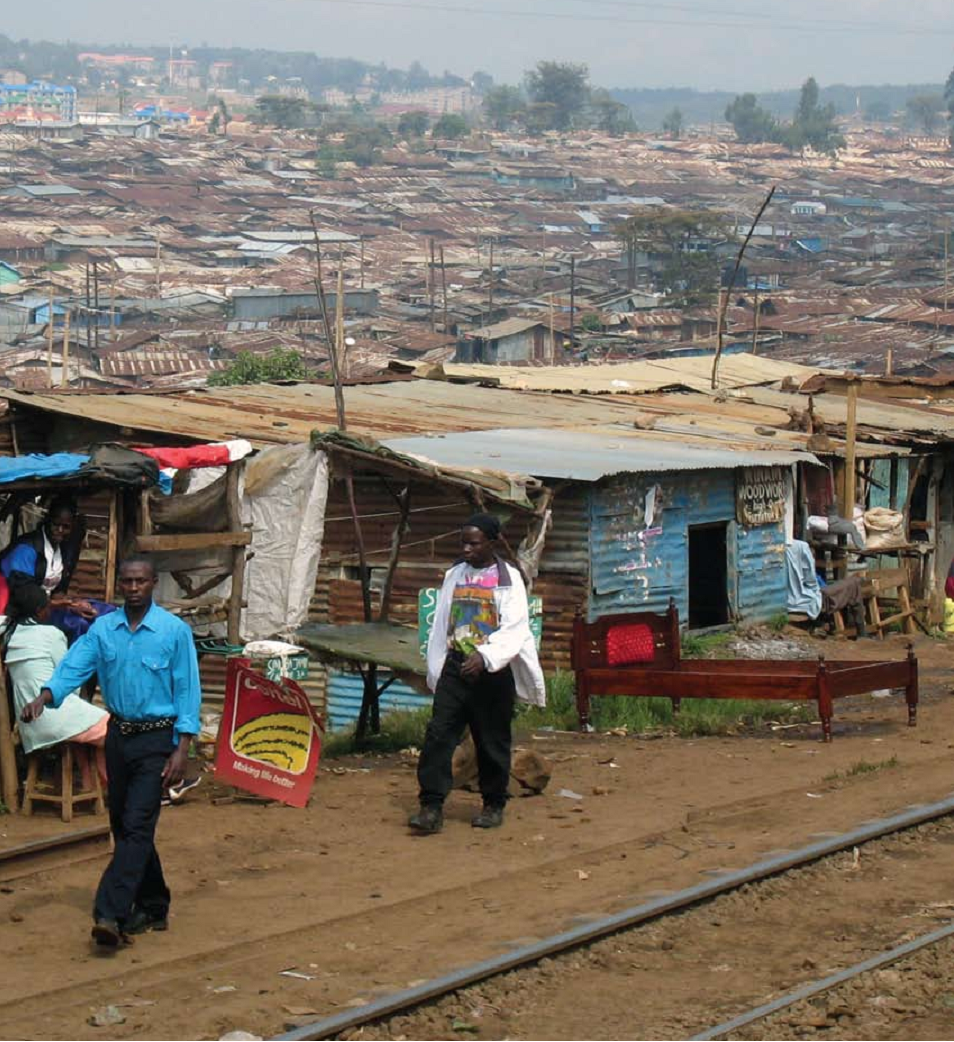
Conclusion
The past one decade has witnessed several changes in the landscape architecture with major changes stirred by the growing technology across the globe. The landscape architecture has advanced from the agrarian garden planning epoch to the modern city-designing era. “Modern Gardens for Modern Houses” was the slogan that can best explain the evolution in the art literature from 20th century. Advanced technology as well as immigration and migration human aspects are the forces behind the heaving radical socioeconomic change within the global development (Arvidsson 239). However, despite proving competent in modern era by providing several prerequisite survival needs including water, power, and elegant systems of transport, the architectural systems has continued to pose threat to human endurance. The perceived modernism in landscape architecture is now proving dangerous, as social aspects of human life including health and sanitation, security, and economic wellbeing have remained in compromise. The consequences of urban city planning that replaced the agrarian age in the nineteenth century are now becoming clear with the number of slums growing in big cities and towns due to the surging competition in rental investment.
Works Cited
Aoki, Keith 1993. Race, space, and place: The relation between architectural modernisms, post-modernism, urban planning, and gentrification.. PDF file. 2
Arvidsson, Adam. “Brands: A critical perspective.” Journal of Consumer Culture 5.2 (2005): 235–258. Print.
Baird, Timothy, and Bonj Szczygiel. “Sociology of Professions: The Evolution of Landscape Architecture in the United States.” Landscape Review 12.1 (2006): 3-25. Print.
Courville, Michael, and Raj Patel 2007, The Resurgence of Agrarian Reform in the Twenty-first Century. PDF file. 2013. Web.
Laurie, Michael. An introduction to landscape architecture, New York: Oxford Press, 1990. Print.
Knorr, Luca. “Early modern landscape architecture the evolution of public p ark theory until the end of the 1930.” Garden History 27.1 (2000): 2-16.Print.
Kuo, Frances 2010, Parks and Other Green Environments: Essential Components of a Healthy Human Habitat, PDF file. Web.
Rainey, Reuben. “Architecture and Landscape: Three modes of relationship.” Places 4.4 (1990): 4-6. Print.
Reed, Peter. Groundswell: Constructing the Contemporary Landscape, New York: The Museum of Modern Art, 2005. Print.
Swaffield, Simon. Theory in Landscape Architecture: A Reader, Pennsylvania: University of Pennsylvania Press, 2002. Print.
Treib, Marc. Modern Landscape Architecture: A Critical Review, New York: MIT Press, 1994. Print.
Proposal: Landscape architecture
Background
Landscape architecture typically refers to an all-inclusive discipline of land investigation, scheduling, invention, preservation, management, and rehabilitation of land. In simpler terms, landscape architecture is a broader term used in defining all activities involved meaningful land use in designing of public land utilities inclusive of landmarks and structures to attain environmentally, socially and aesthetic products. Landscape architecture involves numerous systematic investigations of the prevailing geological, social and ecological conditions of landscapes and serious engagement in a series of interventions on designs to produce desirable land outcomes. In professional approach, the scope of landscape architecture entails land use and reclamation activities that involve environmental restoration through land reclamation, urban scenery designing and planning, visual resource management and green infrastructure planning amongst others. Under the natural and distinct nature of human beings, land use and occupation has remained a critical issue with humans expected to have meditative land policies that govern the proper integration and use of land utility.
Problem statement
The literal discussion of the evolution of the landscape architecture has remained a complex and challenging matter in the research. Landscape architecture typically refers to an all-inclusive discipline of land investigation, scheduling, invention, preservation, management and rehabilitation of land. A reassess of the historiography of the landscape streams from the historical landscape design with traditional societies basing the land use on agricultural productivity as the main approach to the universe. Landscape architecture has lacked consistency in its development throughout successive years with reasons behind its dwindling and resurrection in its development remaining publicly unclear. For decades, landscape designers and planners have remained locked to conventional town making as a model for suitable and sustainable land development in planning innovative or retrofitting existing communities. However, the architectural system has remained questionable about this urban planning system. For this reason, this study provides a critical evaluation of the landscape architecture.
Objectives
- To investigate the resurgence of Land Architecture in the past one decade
- To examine the possible forces behind such resurgence
- To provide a critical review in Resurgence of Land Architecture

